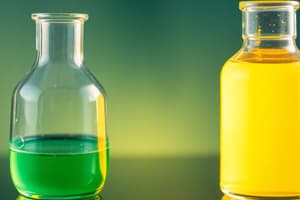Podcast
Questions and Answers
Who was the first scientist to use the term 'element'?
Who was the first scientist to use the term 'element'?
- Dmitri Mendeleev
- John Dalton
- Robert Boyle (correct)
- Antoine Laurent Lavoisier
What is the definition of an element as established by Lavoisier?
What is the definition of an element as established by Lavoisier?
- A basic form of matter that cannot be broken down (correct)
- A mixture of metals and non-metals
- A substance that can be broken down chemically
- A compound formed from two or more elements
Which of the following is NOT a property of metals?
Which of the following is NOT a property of metals?
- Malleability
- Lustre
- Sonority
- Poor conductivity of electricity (correct)
Which of the following elements is liquid at room temperature?
Which of the following elements is liquid at room temperature?
Which category includes elements with intermediate properties between metals and non-metals?
Which category includes elements with intermediate properties between metals and non-metals?
Which of the following is an example of a non-metal?
Which of the following is an example of a non-metal?
What is a defining characteristic of metals?
What is a defining characteristic of metals?
Which of the following best describes non-metals?
Which of the following best describes non-metals?
Which property is NOT typically associated with metalloids?
Which property is NOT typically associated with metalloids?
Which element is classified as a metalloid?
Which element is classified as a metalloid?
What distinguishes the only liquid metal at room temperature?
What distinguishes the only liquid metal at room temperature?
Which property of metals contributes to their ability to be formed into wires?
Which property of metals contributes to their ability to be formed into wires?
Flashcards are hidden until you start studying
Study Notes
Foundations of Element Chemistry
- Robert Boyle introduced the term "element" in 1661.
- Antoine Laurent Lavoisier, a French chemist, defined an element as a basic form of matter that cannot be decomposed into simpler substances by chemical reactions.
Classification of Elements
- Elements are categorized into three main types: metals, non-metals, and metalloids.
Properties of Metals
- Metals typically exhibit a shiny lustre.
- Common colors for metals include silvery-grey or golden-yellow.
- Metals are effective conductors of heat and electricity.
- Ductility allows metals to be stretched into wires.
- Malleability enables metals to be hammered into thin sheets.
- Metals are sonorous, producing a ringing sound when struck.
- Examples: gold, silver, copper, iron, sodium, potassium.
- Mercury is unique as the only metal that is liquid at room temperature.
Properties of Non-Metals
- Non-metals can display a wide range of colors.
- Generally poor conductors of heat and electricity.
- Lack lustre and do not produce a ringing sound; they are neither malleable nor ductile.
- Examples: hydrogen, oxygen, iodine, carbon (in forms like coal and coke), bromine, chlorine.
Metalloids
- Metalloids possess intermediate properties between metals and non-metals.
- Common examples include boron, silicon, and germanium.
Foundations of Element Chemistry
- Robert Boyle introduced the term "element" in 1661.
- Antoine Laurent Lavoisier, a French chemist, defined an element as a basic form of matter that cannot be decomposed into simpler substances by chemical reactions.
Classification of Elements
- Elements are categorized into three main types: metals, non-metals, and metalloids.
Properties of Metals
- Metals typically exhibit a shiny lustre.
- Common colors for metals include silvery-grey or golden-yellow.
- Metals are effective conductors of heat and electricity.
- Ductility allows metals to be stretched into wires.
- Malleability enables metals to be hammered into thin sheets.
- Metals are sonorous, producing a ringing sound when struck.
- Examples: gold, silver, copper, iron, sodium, potassium.
- Mercury is unique as the only metal that is liquid at room temperature.
Properties of Non-Metals
- Non-metals can display a wide range of colors.
- Generally poor conductors of heat and electricity.
- Lack lustre and do not produce a ringing sound; they are neither malleable nor ductile.
- Examples: hydrogen, oxygen, iodine, carbon (in forms like coal and coke), bromine, chlorine.
Metalloids
- Metalloids possess intermediate properties between metals and non-metals.
- Common examples include boron, silicon, and germanium.
Studying That Suits You
Use AI to generate personalized quizzes and flashcards to suit your learning preferences.




